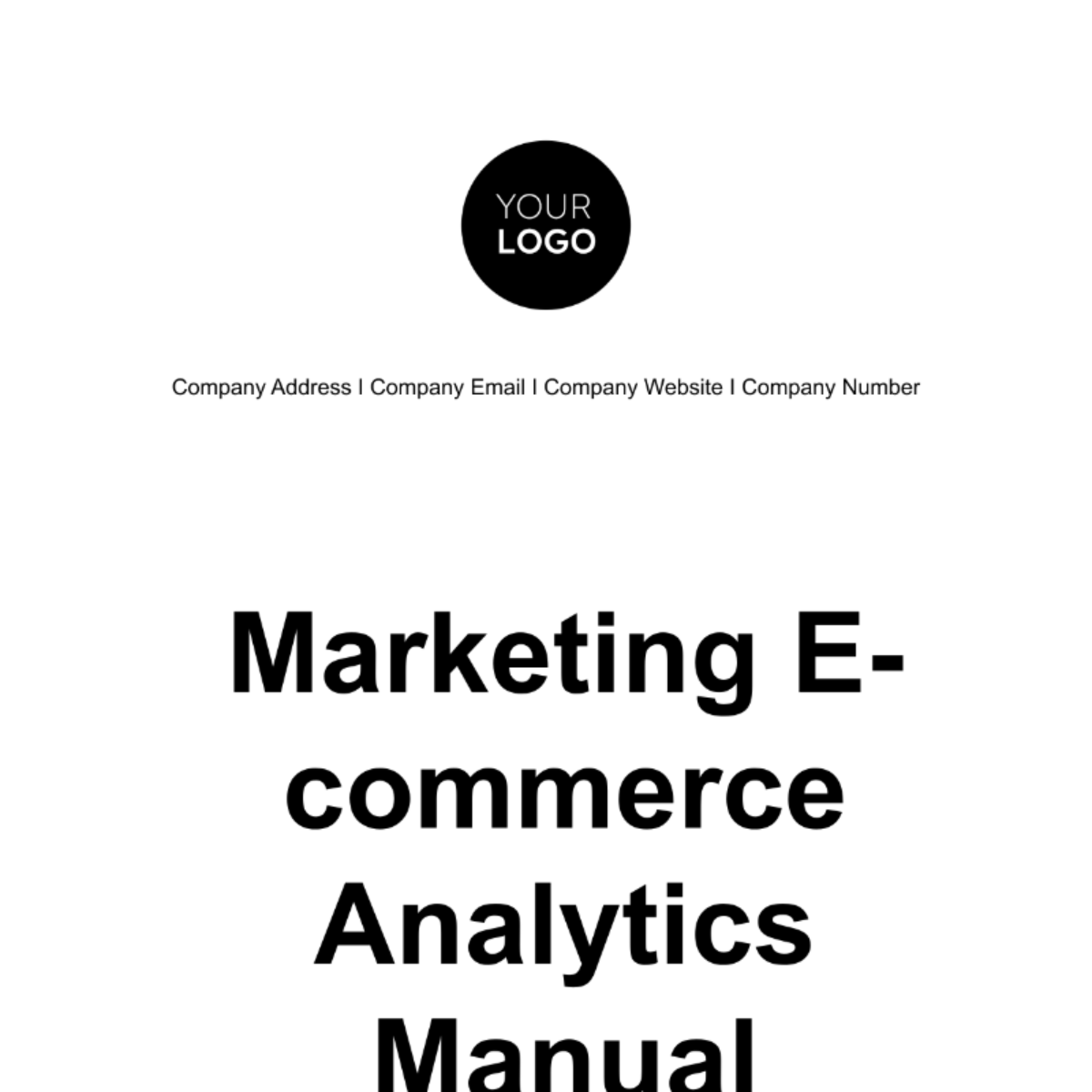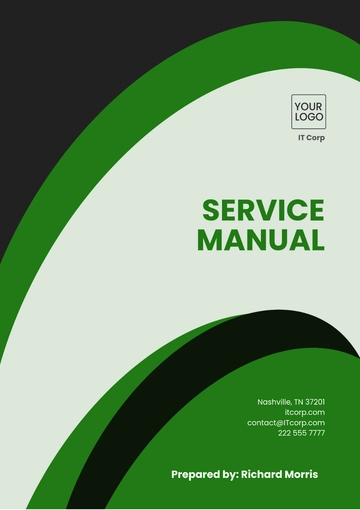Free Marketing E-commerce Analytics Manual

1. Introduction
1.1 Purpose of the Manual:
This Marketing E-commerce Analytics Manual serves as a comprehensive guide for [Your Company Name]'s marketing professionals to effectively analyze and measure the performance of our e-commerce marketing campaigns and activities. It outlines the best practices and methodologies for harnessing data-driven insights to make informed decisions.
1.2 Importance of E-commerce Analytics:
In today's digital landscape, understanding and harnessing the power of data is essential for e-commerce success. E-commerce analytics empowers us to gain a deeper understanding of customer behavior, optimize marketing strategies, and maximize ROI. By leveraging data, we can tailor our marketing efforts to drive more traffic, increase conversions, and ultimately boost revenue.
2. Goals and Objectives
2.1 Define Specific Marketing Goals:
Goal 1: Increase the conversion rate on our e-commerce website by optimizing the checkout process.
Goal 2: Enhance customer retention by implementing personalized email marketing campaigns.
Goal 3: Improve social media engagement and brand visibility through targeted content.
2.2 Outline Objectives for E-commerce Analytics:
Objective 1: Identify and eliminate bottlenecks in the checkout process to reduce cart abandonment.
Objective 2: Segment the customer base for personalized email campaigns to increase repeat purchases.
Objective 3: Monitor social media performance metrics to gauge the impact of content strategies.
3. Key Performance Indicators (KPIs)
3.1 Identify Relevant Metrics:
Conversion Rate
Revenue per Visitor
Customer Acquisition Cost (CAC)
Average Order Value (AOV)
Cart Abandonment Rate
Click-Through Rate (CTR)
Return on Ad Spend (ROAS)
Customer Lifetime Value (CLTV)
3.2 KPI Definitions:
Conversion Rate: The percentage of website visitors who complete a desired action, such as making a purchase.
Revenue per Visitor: Total revenue generated divided by the number of visitors.
Customer Acquisition Cost (CAC): The cost associated with acquiring a new customer.
Average Order Value (AOV): The average amount spent by a customer in a single transaction.
Cart Abandonment Rate: The percentage of users who add items to their cart but do not complete the purchase.
Click-Through Rate (CTR): The ratio of users who click on a specific link to the number of total users who view a page or email.
Return on Ad Spend (ROAS): The revenue generated from advertising campaigns compared to the cost of those campaigns.
Customer Lifetime Value (CLTV): The predicted net profit attributed to the entire future relationship with a customer.
3.3 Target KPI Values:
Conversion Rate Target: Achieve a 10% increase in the conversion rate by the end of the quarter.
Revenue per Visitor Target: Increase revenue per visitor by 15% compared to the previous year.
Customer Acquisition Cost (CAC) Target: Reduce CAC by 20% through improved targeting and efficiency.
Average Order Value (AOV) Target: Raise AOV to $100 by the end of the fiscal year.
Cart Abandonment Rate Target: Decrease the cart abandonment rate to below 40%.
Click-Through Rate (CTR) Target: Achieve a 12% CTR for email marketing campaigns.
Return on Ad Spend (ROAS) Target: Attain a 400% ROAS for paid advertising efforts.
Customer Lifetime Value (CLTV) Target: Increase CLTV by 25% through enhanced customer retention strategies.
4. Data Sources
Google Analytics
Shopify
Facebook Insights
Twitter Analytics
Other Email Marketing Sources
5. Data Collection
5.1 Data Collection Methods:
Effective data collection is the foundation of e-commerce analytics. To gather the necessary data, we utilize various methods:
Website Tracking: Implement tracking codes from Google Analytics or other analytics tools on our e-commerce website to capture user interactions and behavior.
Event Tracking: Set up event tracking for specific actions, such as button clicks, form submissions, and downloads, to gain deeper insights into user engagement.
E-commerce Platform Data: Utilize built-in analytics features of our e-commerce platform (e.g., Shopify) to collect sales, inventory, and product data.
Social Media Monitoring: Leverage social media analytics to track engagement, reach, and user interactions across different platforms.
Email Marketing Data Collection: Use email marketing platforms to track email campaign performance, including open rates, click-through rates, and conversion rates.
External Data Sources: Integrate data from external sources, such as market research or third-party APIs, to enrich our analytics datasets.
5.2 Tagging and Tracking Setup:
Proper tagging and tracking setup are crucial to ensure data accuracy and consistency. Here are key considerations:
URL Parameters: Implement UTM parameters in URLs for campaign tracking, allowing us to attribute traffic to specific marketing efforts.
E-commerce Tracking: Configure e-commerce tracking tags to monitor sales, revenue, and product performance.
Event Tracking: Set up event tracking for critical actions (e.g., form submissions, video views) to understand user behavior.
Cross-Domain Tracking: Implement cross-domain tracking if our e-commerce operations span multiple domains.
5.3 Data Storage:
Data storage must be secure, organized, and compliant with data privacy regulations. Our data storage practices include:
Secure Servers: Ensure data is stored on secure servers with encryption to protect sensitive information.
Regular Backups: Implement regular data backups to prevent data loss in case of unexpected incidents.
Data Retention Policies: Establish clear data retention policies to manage the lifespan of collected data.
Access Control: Restrict access to data to authorized personnel only and maintain audit logs of data access.
6. Data Analysis
6.1 Analytical Methods:
To extract meaningful insights from our data, we employ various analytical methods:
Descriptive Analytics: Summarize and visualize historical data to understand trends and patterns.
Predictive Analytics: Use statistical models and machine learning algorithms to forecast future outcomes, such as sales or customer behavior.
Prescriptive Analytics: Recommend actions and strategies based on insights to optimize marketing efforts.
6.2 Segmentation Strategies:
Segmenting data into meaningful groups helps us target specific audiences and tailor marketing campaigns. We utilize segmentation based on criteria such as:
Demographics
Geographic location
Behavior (e.g., browsing history, purchase history)
Engagement (e.g., email opens, click-throughs)
6.3 Cohort Analysis:
Cohort analysis allows us to track the behavior of specific groups of customers over time. Common cohorts include:
New customers
Returning customers
Customers acquired from specific marketing channels
6.4 A/B Testing:
A/B testing is essential for optimizing marketing campaigns. We conduct A/B tests by:
Splitting audiences into two groups (A and B)
Testing variations of marketing elements (e.g., ad copy, email subject lines)
Measuring performance to determine the most effective version
6.5 Data Visualization Tools:
Effective data visualization tools help us present insights in a clear and digestible manner. We use tools such as:
Data dashboards (e.g., Tableau, Power BI)
Charts and graphs
Heatmaps
Infographics
7. Reporting
7.1 Report Frequency:
Timely reporting ensures that stakeholders have access to up-to-date insights. Our reporting schedule includes:
Daily reports for critical metrics
Weekly reports for campaign performance
Monthly reports for overall trends
Quarterly and annual reports for strategic planning
7.2 Key Stakeholders:
Identify key stakeholders who rely on our analytics reports:
Marketing team
Sales team
Executive leadership
Product development
IT and web development
7.3 Report Templates:
Standardized report templates streamline the reporting process. Our templates include:
Cover page with report title and date
Executive summary highlighting key insights
Detailed sections for each KPI and campaign
Visualizations and graphs for data presentation
7.4 Actionable Insights:
The ultimate goal of our reports is to provide actionable insights that guide decision-making. Each report should include:
Recommendations for optimization
Insights into what worked and what needs improvement
Clear action items for relevant teams
8. Data Privacy and Compliance
8.1 GDPR Compliance:
[Your Company Name] is committed to complying with the General Data Protection Regulation (GDPR). Our GDPR compliance measures include:
Obtaining explicit consent for data collection
Providing transparent data processing information
Ensuring the right to data access and erasure for individuals
Regularly auditing and updating data handling practices to align with GDPR requirements
8.2 CCPA Compliance:
In compliance with the California Consumer Privacy Act (CCPA), we adhere to the following principles:
Informing consumers about data collection and sharing practices
Offering opt-out options for data sale
Safeguarding consumer data and responding to data access requests
8.3 Data Handling Policies:
We maintain comprehensive data handling policies to ensure data security and integrity. These policies cover:
Data classification and labeling
Data access controls and permissions
Data encryption in transit and at rest
Data breach response procedures
9. Tools and Software
9.1 Analytics Tools:
[Your Company Name] employs various analytics tools to extract and analyze data effectively. These tools include:
Google Analytics: Used for web traffic analysis, audience insights, and goal tracking.
Adobe Analytics: Offers advanced analytics capabilities for deeper data analysis.
Tableau: Used for creating interactive data visualizations and dashboards.
Google Data Studio: A data visualization tool for creating shareable, interactive reports.
9.2 Software Requirements:
To ensure seamless data analysis, the following software requirements should be met:
Up-to-date web browsers for accessing online analytics platforms.
Compatibility with analytics tools and plugins.
Adequate hardware resources for running data-intensive analytics software.
9.3 Training and Resources:
We provide training and resources to empower our teams to utilize analytics tools effectively:
Internal Training: Regular training sessions and workshops on analytics tools and techniques.
External Resources: Access to online courses, documentation, and industry conferences.
Support Channels: A dedicated support team to assist with tool-related queries.
10. Roles and Responsibilities
Team | Roles and Responsibilities |
Data Analysts: |
|
Marketers: |
|
Developers: |
|
Stakeholder Roles: |
|
11. Continuous Improvement
11.1 Feedback Loop:
We maintain a feedback loop to ensure ongoing improvement:
Regular Meetings: Hold regular meetings to review analytics findings and gather feedback.
Feedback Channels: Establish communication channels for team members to provide input on analytics processes.
Iterative Feedback: Use feedback to make incremental improvements to marketing strategies.
11.2 Optimization Strategies:
Based on analytics insights, we continually optimize our marketing strategies:
Data-Driven Decisions: Make informed decisions backed by data analysis.
Experimentation: Experiment with different marketing approaches and measure their impact.
Responsive Campaigns: Adjust campaigns in real-time based on changing customer behavior.
11.3 Iterative Marketing:
Our marketing approach is iterative and adaptive:
Continuous Testing: Test and refine marketing elements such as ads, emails, and landing pages.
Data-Backed Creativity: Combine creativity with data insights to develop effective marketing content.
Agile Marketing: Adapt marketing strategies quickly in response to performance data.
12. Documentation and Standardization
12.1 Process Documentation:
We maintain detailed documentation of our analytics processes:
Data Collection: Document data collection methods, tools, and sources.
Data Analysis: Outline analytical methods and techniques used for different types of data.
Reporting: Standardize reporting templates and procedures.
12.2 Tracking Guidelines:
Clear tracking guidelines ensure consistency and accuracy:
Tracking Codes: Specify where and how tracking codes should be implemented.
Event Tracking: Document the events to be tracked and their significance.
Tagging Standards: Define naming conventions for tracking tags and events.
12.3 Reporting Standards:
Standardized reporting ensures clarity and consistency:
Report Structure: Define the structure of reports, including sections and content.
Data Presentation: Specify how data should be presented, including charts and visualizations.
Frequency: Set reporting schedules for different stakeholders.
12.4 Data Privacy and Compliance:
GDPR Compliance: Document our GDPR compliance measures, including consent management and data access procedures.
CCPA Compliance: Outline compliance with the California Consumer Privacy Act, covering data rights and opt-out options.
Data Handling Policies: Document policies related to data classification, access control, encryption, and data breach response.
12.5 Change Management:
Change Procedures: Detail the process for making changes to tracking codes, data collection methods, or reporting templates.
Version Control: Implement version control for tracking codes and documentation to track changes and updates.
12.6 Training and Onboarding:
Training Materials: Provide training materials for new team members on data analytics processes and tools.
Onboarding: Include analytics training as part of the onboarding process for new hires.
12.7 Review and Audit:
Regular Audits: Schedule periodic audits of data collection, tracking, and analysis processes to ensure accuracy and compliance.
Documentation Review: Review and update documentation as needed to reflect changes in processes or tools.
13. Conclusion and Next Steps
In conclusion, this Marketing E-commerce Analytics Manual serves as a comprehensive guide to empower [Your Company Name]'s marketing professionals with the knowledge and tools necessary to harness the power of data for informed decision-making. By adhering to the guidelines and best practices outlined in this manual, we are well-equipped to optimize our e-commerce marketing efforts, drive growth, and achieve our goals.
As we move forward, it is essential to maintain a culture of continuous improvement. Regular feedback, collaboration, and adaptability are key to our success in the dynamic landscape of e-commerce. Together, we will leverage data to drive innovation, enhance customer experiences, and achieve remarkable results.
Thank you for your commitment to data-driven excellence. If you have any questions or require further clarification on any aspect of this manual, please do not hesitate to reach out to the analytics team or refer to the provided resources.
[Your Company Name]
[Your Company Email]
[Your Company Address]
[Your Company Number]
[Your Company Website]
[Your Company Social Media]
Prepared By:
[Your Name]
[Your Email]
- 100% Customizable, free editor
- Access 1 Million+ Templates, photo’s & graphics
- Download or share as a template
- Click and replace photos, graphics, text, backgrounds
- Resize, crop, AI write & more
- Access advanced editor
Enhance your e-commerce analytics with our Marketing E-commerce Analytics Manual Template, available on Template.net. This customizable resource offers a structured framework for analyzing key metrics and trends in your online store. Utilize our AI Editor Tool for seamless customization tailored to your business's needs. Gain valuable insights and optimize your e-commerce performance with this essential template for marketing professionals.





























